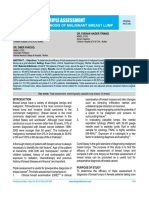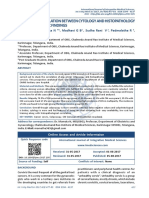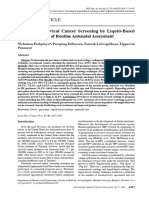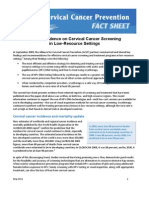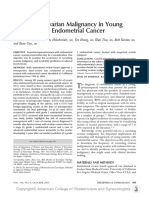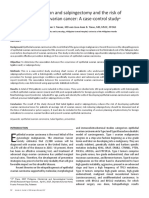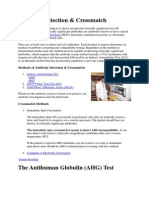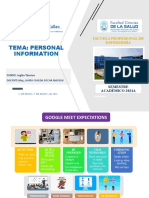Study of Fine Needle Aspiration Cytology of Breast Lump: Correlation of Cytologically Malignant Cases With Their Histological Findings
Study of Fine Needle Aspiration Cytology of Breast Lump: Correlation of Cytologically Malignant Cases With Their Histological Findings
Uploaded by
Arvind Vashi AroraCopyright:
Available Formats
Study of Fine Needle Aspiration Cytology of Breast Lump: Correlation of Cytologically Malignant Cases With Their Histological Findings
Study of Fine Needle Aspiration Cytology of Breast Lump: Correlation of Cytologically Malignant Cases With Their Histological Findings
Uploaded by
Arvind Vashi AroraOriginal Description:
Original Title
Copyright
Available Formats
Share this document
Did you find this document useful?
Is this content inappropriate?
Copyright:
Available Formats
Study of Fine Needle Aspiration Cytology of Breast Lump: Correlation of Cytologically Malignant Cases With Their Histological Findings
Study of Fine Needle Aspiration Cytology of Breast Lump: Correlation of Cytologically Malignant Cases With Their Histological Findings
Uploaded by
Arvind Vashi AroraCopyright:
Available Formats
Study of Fine Needle Aspiration Cytology of Breast Lump: Correlation of
Cytologically Malignant Cases with Their Histological Findings
Touhid Uddin Rupom1, Tamanna Choudhury 2, Sultana Gulshana Banu 3
1Lecturer,
Department of Pathology, National Institute of Cancer Research and Hospital (NICRH), Mohakhali, Dhaka, 2 Associate
Professor, Department of Pathology, Bangabandhu Sheikh Mujib Medical University (BSMMU), Dhaka, 3Assistant Professor, Department
of Pathology, Bangabandhu Sheikh Mujib Medical University (BSMMU), Dhaka
Abstract:
Background: In Bangladesh a large number of patients have been suffering from breast cancer and with each passing
year, the number is increasing. Objectives: To correlate breast lesions diagnosed as cytologically malignant with their
histological findings. Methods: This is a prospective study carried out in the Department of Pathology, BSMMU, Dhaka
during the period of January 2009 to December 2009. Patients with breast lump, having malignant breast lesions on
cytology were included in the study. A total of 524 patients with breast lump underwent FNA examination for the
diagnosis during this period. FNA slides were examined under light microscope after Papanicolaou staining and were
categorized into five groups: i) inadequate ii) benign iii) atypical cells iv) suspicious for malignancy and v) malignant. Of
these, 431 were diagnosed as benign, 4 as atypical, 17 were diagnosed as suspicious for malignancy and 72 cases were
diagnosed as malignant. Out of these 72 cases, which were cytologically diagnosed as malignant, 55 corresponding
surgical specimens (either mastectomy or lumpectomy specimens) were received for histopathology. The sections were
stained with haematoxylin and eosin for microscopic examination. Results: 55 cases which were diagnosed as malignant
by FNAC were found to be malignant by histopathology. 54 (98.18%) were invasive ductal carcinoma (NOS) and one
(1.82%) was mucinous carcinoma. In this study, considering only cases with a definitive diagnosis of malignancy, the
sensitivity of FNAC to diagnose the disease was 100% and accuracy was 100% and Chi-square test revealed Chi-square
value 10.83 (P< 0.001). Conclusion: From the present study it is evident that FNAC is a simple and reliable method. No
local anaesthesia is required. Operative risk of surgical biopsy, danger of post operative infection can be avoided by
adopting the procedure. It helps to confirm the clinical impression without open biopsy.
Key words: Breast lump; FNAC; Mastectomy; Malignancy.
[BSMMU J 2011; 4(2):60-64]
Introduction:
In Bangladesh, patients suffering from breast cancer have
been increasing. Because of the existing social
circumstances, the tendency to overlook the complaints,
and because female patients are hesitant to be examined
by the clinicians for lump in the breast, they report in
advanced stage of breast cancer1. FNAC of breast lump
can be effectively used as a diagnostic tool in the diagnosis
and management of breast lump on an outpatient basis as
hospitalization of the patient is not necessary. Fine needle
aspiration cytology (FNAC) of breast is an important part
of the triple assessment of palpable breast lump (clinical
examination, imaging [mammography or ultrasonography],
and FNAC). It has been shown that FNAC can reduce the
number of open biopsies2. The most common sign and
symptom of breast disease is a palpable mass; although
breast diseases can also present as inflammatory lesion,
nipple secretion or imaging abnormalities3.
Address of correspondence: Dr. Touhid Uddin Rupom,
Lecturer, Department of Pathology, National Institute of
Cancer Research and Hospital (NICRH), Mohakhali, Dhaka,
Email: touhidrupom@yahoo.com
FNAC is now used more frequently to diagnose any mass
in the breast, which is clinically malignant. It is extremely
beneficial in reaffirming the clinical impression of benign
disease, which may not need subsequent biopsy.
Furthermore, it allows more rapid diagnosis of a malignant
condition in clinically non-suspicious masses. The ultimate
benefit of aspiration cytology, however, rests in its
demonstration of malignant disease, when other diagnostic
modalities are inconclusive 4 . FNAC is now a well
established tool for the investigation of women with
suspected breast carcinoma5. A cytodiagnosis based on
the examination of smears prepared from the aspirate can
accurately predict the histology of the tumour in about
90% of cases6.
It has improved decision making and the selection of
patients for biopsy of breast lesion and has contributed in
saving time in the clinical management of breast disease7.
Advantage is that when the cytological diagnosis is a
malignant lesion, the nature of the condition can be
discussed with the patient and a full explanation of the
proposed operation, length of stay in hospital and after
care can be given8.
BSMMU J
Vol. 4, Issue 2, July 2011
The present study is designed to correlate findings of
cytologically malignant breast lesions of patients attending
outpatient department, with their histomorphologic findings.
Methods:
It was a prospective type of study carried out in the
Department of Pathology, BSMMU, Dhaka, during the period
of January 2009 to December 2009 and the study was approved
by the departmental ethical committee. Patients with breast
lump, initially diagnosed as malignant on FNA cytology were
included in the study. A total of 524 patients with breast lump
underwent FNA examination for evaluation during this period.
FNA slides were examined under light microscope after
Papanicolaou staining and were categorized into five groups:
i) inadequate ii) benign iii) atypical cells iv) suspicious for
malignancy and v) malignant. Of these, 431 were diagnosed
as benign, 4 as atypical, 17 were diagnosed as suspicious for
malignancy and 72 cases were diagnosed as malignant and
were graded by Robinsons Cytology Grading System. Out
of these 72 cases, cytologically diagnosed as malignant, 55
corresponding surgical specimens (either mastectomy or
lumpectomy specimens) were received for histopathological
examination subsequently. Specimens were fixed in 10%
formalin solution, routinely processed, sectioned and stained
with hematoxylin and eosin staining methods for microscopic
examination and were graded by Bloom Richardson Scoring
System. Cytological findings of malignant cases were
correlated with their histologic findings. Sensitivity and
accuracy of diagnosis were calculated using Chi-square
test.
Results:
The age range of total 55 patients was 20-80 years with the
mean age of 43.2 years. Highest frequency of malignant
breast lump was found in the age group of 36-45 years.
Out of 55 patients, 32 had lump in the right breast and 23
had lump in the left breast. In both right and left breasts,
highest percentage was located in the upper and outer
quadrant (29.09% and 18.18% respectively).
Correlation between cytopathologic and histopathologic
diagnosis:
All the 55 cases diagnosed malignant by FNAC were found
to be malignant by histopathology. 54 (98.18%) were
invasive ductal carcinoma (NOS) (Fig: 1) and one (1.82%)
was mucinous carcinoma. (Fig: 2) (Table-I)
Cytologic findings (FNAC):
Out of 55 cases, 54 were ductal carcinoma and only one
was mucinous carcinoma. Out of the 54 ductal carcinoma
(NOS), 11 were in grade-I, 43 were in grade- II. No case
was diagnosed as grade- III (Fig-3).
Histologic findings:
Out of 55 patients, 54 were diagnosed as invasive ductal
carcinoma (NOS) and one was mucinous carcinoma.
Among 54 patients with invasive ductal carcinoma (NOS),
36 cases were in grade- II, 17 were in grade- I and one was
in grade- III. (Fig-4).
Cytologic grading compared with the histologic grade:
It was found that out of 17 cases of histological grade- I,
10 were cytologically in grade- I and 7 were in grade- II.
Out of 36 cases which were histologically in grade- II, 35
were cytologically in grade- II and one was in grade- I.
One patient with histological grade- III was grade- II
cytologically (Fig-5).
Statistical analysis by Chi-square test showed that
cytological grade significantly correlated with histological
grade, P<0.001.
Evaluation of cytopathologic diagnosis and histologic findings:
In this study, the sensitivity of the test (FNAC) to diagnose
malignant breast diseases was 100%.
The overall diagnostic accuracy of FNAC in the present
study was 100%. Statistical analysis by Chi-square test
revealed Chi-square value 10.83 (P< 0.001), which is
statistically significant. Sensitivity of FNAC obtained by
various workers ranges from 97% to100% and present
study correlates with that study (Table-II). So there is
strong correlation between cytologically malignant cases
with their histologic findings.
Table- I
Cytologic and histopathologic correlation of 55(n) cases with malignant breast lesions.
Cytology
Total 55(n)
(FNAC)(n=55)
Ductal
Mucinous
Medullary
Lobular
Others
54
1
-
Percentage of (+) ve correlation= 100%.
61
Histology (n=55)
Ductal
Mucinous
Medullary
Lobular
Others
54
-
1
-
Study of Fine Needle Aspiration Cytology of Breast Lump: Correlation of Cytologically Malignant
Rupom et al
Table- II
Comparative evaluation of FNAC of the present study with other studies.
Authors
Aspiration
Russ et al 1978
257
143
100
30
184
73
125
63
219
93
939
211
276
35
239
86
524
55
Lannin et al 1984
Wollenberget al 1985
Hammond et al 1985
Silverman et al 1987
Friechteret al 1997
Willkison et al 1989
Chiemchanya et al 2000
Present Study2010
(T)
(M)
(T)
(M)
(T)
(M)
(T)
(M)
(T)
(M)
(T)
(M)
(T)
(M)
(T)
(M)
(T)
(M)
False positive
False negative
Sensitivity
Accuracy
94%
4%
87%
96%
25%
65%
91%
0.8%
3.2%
94%
95.40%
4.4%
82.2%
96%
0.6%
14.2%
86%
54.80%
79.4%
92.4%
2%
92.6%
97.5%
100%
100%
T= Total, M= Malignant
Fig-1: Ductal Carcinoma (NOS).
Fig-3: Distribution of cases by Robinsons cytology
grading system
Fig-2: Mucinous Carcinoma
Fig-4: Distribution of cases by Bloom Richardsons
histologic grading system
62
BSMMU J
Vol. 4, Issue 2, July 2011
both systems are nuclear pleomorphism. Development of
a grading system common to both cytology and histology
can significantly reduce the discordance.
In the present study, lumps were found more frequent in
the right breast than in the left. Upper and outer quadrant
of the breast was found most frequently involved. The
highest frequency was found in the 4th decade of life.
This observation is almost same as that of Eisenberg et al,
198610.
Fig-5: Comparison of histological and cytological
grading by Bar Diagram.
Discussion:
Breast cancer is one of the common clinical problems in
Bangladesh. Although there has been little success in
preventing breast cancer, significant reduction of mortality
could be achieved by early detection. It is the general
consensus that a firm pre-operative diagnosis should be
established before surgery and FNAC is an extremely
useful diagnostic technique. It has already been
established that FNAC is an easily performed outpatient
diagnostic method for determining the nature of breast
lesion. Its success is due to its diagnostic accuracy and
its cost effectiveness in the management of breast lump.
As a diagnostic modality, FNA cytology has many
advantages for the patients as well as for the physicians.
Before the introduction of FNAC, open biopsy/true cut
biopsy was carried out in only suspicious cases. The
purpose of this present study was to determine the value
of fine needle aspiration cytology in the diagnosis of breast
carcinoma and to compare the result of FNAC with
histological diagnosis to assess its accuracy. Keeping in
mind the aim and objectives of the present study, 55 cases
which were diagnosed as malignant breast lesions on
FNAC, were correlated with their histological diagnosis.
All the cytologically diagnosed malignant lesions were
proved to be malignant on histology. All but one of 55
cases of breast carcinoma was invasive ductal carcinoma
which was the most common group (98.18%).
Chiemchanya et al, 2000 reported a similar finding from
FNAC of the breast lumps9. In this study, 45 cases showed
correlation between histologic and cytologic grades.
Maximum correlation occurred in grade- II. Only 9 cases
showed no correlation. This discrepancy between
cytological and histological grades is possibly due to
dissimilar criteria of the grading systems and appears to
occur in the lower grades. The only common criteria in
63
The diagnostic accuracy of the present study is 100%
which correlates well with Chiemchanya et al, 20009. The
data indicate that when adequate, well prepared samples
are submitted, accurate cytological diagnosis can be made.
The high predictive value of positive results allows for
early diagnosis, treatment and management of breast
cancer.
Conclusion:
The present study shows that FNAC is a reliable method.
It helps to confirm the clinical impression without open
biopsy. The most important aspect of this procedure lies
on the diagnosis of malignancy. With adequate number of
trained cytopathologists this procedure can be extended
to all the Medical Colleges and district hospitals of
Bangladesh and this will help in pre-operative management
of the patients and to take decision about the type of
surgery. From this study it can be concluded that diagnosis
of breast carcinoma from fine needle aspiration cytology
(FNAC) should be practiced as a routine procedure as
there is a high degree of correlation with histopathological
findings. Now-a-days, neoadjuvant chemotherapy is
increasingly being offered to the patients with invasive
breast carcinoma. In this regard, FNAC as an alternative
to histological examination is an important denominator
for planning of management where core biopsy of breast
is not practised in Bangladesh. Experience gained from
this study further advocates that FNAC could be an ideal
method for follow-up of malignant cases, especially when
there is recurrence.
References:
1.
Bhuiya MAH. Incidence of carcinoma in patients presenting
with breast lump, a study of 100 cases [FCPS dissertation].
Bangladesh College of Physicians and Surgeons; 1990. Part 2,
Surgery; p- 1.
2.
Hindle WH, Payne PA, Pan Ey. The use of FNA in the
evaluation of persistent palpable dominant breast masses. Am
J Obstetrics Gynaecol 1993; 168 (6 part 1) : 1814-8.
3.
Klin TS and Neal HS. Role of needle aspiration biopsy in
diagnosis of carcinoma of breast. Obstetrics and Gynecology
1975; 46:89-92.
Study of Fine Needle Aspiration Cytology of Breast Lump: Correlation of Cytologically Malignant
Rupom et al
4.
Russ JE, Winchester DP, Scanlon EF, Christ MA. Cytologic
findings of aspiration of tumours of the breast. Surg. Gynecol
Obstetric 1978; 146: 407-411.
7.
Feichter E G, Haberthur F, Gobat S, Dalquen P. Breast cytology
statistical analysis and cytohistologic correlation. Acta Cyto
1997; 41:327-332.
5.
Baak J.P.A. The relative prognostic significance of nucleolar
morphology in invasive ductal breast cancer. Histopathology
1985; vol-9, p-37.
8.
Davies C.J. Elston C.W, Cotton R.E. and Blamey R.W.
Preoperative diagnosis in carcinoma of the breast. Br J Surg
1977; 64:326-328.
9.
6.
Graaf D.H, Willemse P, Ladde B.E, Van Den H.A, Bergen, M.
Krebber, Tjabbes T and Sluiter W.J. Evaluation of a cytological
scoring system for predicating histological grade and disease
free survival in primary breast cancer. Cytopathology 1994;
5:293-300.
Chiemchanya S and Mostafa MG. Fine Needle Aspiration
Cytology in the Diagnosis of Breast lump. Journal of
Bangladesh College of Physicians and Surgeons 2000; 18:6165.
64
10. Eisenberg AR, J, Hadju S I, Wilhelmus M R, Kinne D.
Preoperative aspiration cytology of breast tumours. Acta
Cyto.1986; 30:135-146.
You might also like
- Case Study of Hospital Fortis Hospital I PDFNo ratings yetCase Study of Hospital Fortis Hospital I PDF20 pages
- Accuracy of Triple Test Score in The Diagnosis of Palpable Breast LumpNo ratings yetAccuracy of Triple Test Score in The Diagnosis of Palpable Breast Lump4 pages
- Assessing The Effectiveness of A Cervical Cancer S 2015 Biomedical and EnvirNo ratings yetAssessing The Effectiveness of A Cervical Cancer S 2015 Biomedical and Envir5 pages
- 19 - Benefits of Cervical Cancer Screening by Liquid-BasedNo ratings yet19 - Benefits of Cervical Cancer Screening by Liquid-Based5 pages
- Comparing The Effectiveness of Liquid Based Cytology With Conventional PAP SmearNo ratings yetComparing The Effectiveness of Liquid Based Cytology With Conventional PAP Smear5 pages
- Banik T - Cytomorphology of Breast Lesions With Historadiological Correlation in A Tertiary Care Centre of PuducherryNo ratings yetBanik T - Cytomorphology of Breast Lesions With Historadiological Correlation in A Tertiary Care Centre of Puducherry6 pages
- Radiological and Cytological Correlation of Breast Lesions With Histopathological Findings in A Tertiary Care Hospital in Costal KarnatakaNo ratings yetRadiological and Cytological Correlation of Breast Lesions With Histopathological Findings in A Tertiary Care Hospital in Costal Karnataka4 pages
- Individual Management of Cervical Cancer in Pregnancy (Jurnal Ana)No ratings yetIndividual Management of Cervical Cancer in Pregnancy (Jurnal Ana)12 pages
- Predicting Endometrial Hyperplasia and Endometrial Cancer On Recurrent Abnormal Uterine BleedingNo ratings yetPredicting Endometrial Hyperplasia and Endometrial Cancer On Recurrent Abnormal Uterine Bleeding7 pages
- Prognostic Factors For Breast Cancer Recurrence After Conservative TreatmentNo ratings yetPrognostic Factors For Breast Cancer Recurrence After Conservative Treatment5 pages
- Breast Fine Needle Aspiration Cytology Reporting Icet13i2p54No ratings yetBreast Fine Needle Aspiration Cytology Reporting Icet13i2p546 pages
- Comparison of Ultrasound and Mammography For Early DiagnosisNo ratings yetComparison of Ultrasound and Mammography For Early Diagnosis8 pages
- Full Title: Accuracy of Clinical Breast Examination's AbnormalitiesNo ratings yetFull Title: Accuracy of Clinical Breast Examination's Abnormalities21 pages
- Cervical Cytology in Women With Abnormal Cervix.: Dr. Veena Rahatgaonkar, Dr. Savita MehendaleNo ratings yetCervical Cytology in Women With Abnormal Cervix.: Dr. Veena Rahatgaonkar, Dr. Savita Mehendale4 pages
- Residual Breast Tissue After Mastectomy, How Often and Where It Is LocatedNo ratings yetResidual Breast Tissue After Mastectomy, How Often and Where It Is Located11 pages
- Dawande P-Correlation Between Cytological and Histological Grading of Breast Cancer and Its Utility in Patient's ManagementNo ratings yetDawande P-Correlation Between Cytological and Histological Grading of Breast Cancer and Its Utility in Patient's Management6 pages
- Cervical Cancer Screening With Human Papillomavirus DNA and Cytology in JapanNo ratings yetCervical Cancer Screening With Human Papillomavirus DNA and Cytology in Japan7 pages
- ST Gallen Molecular Subtypes in Screening-Detected and Symptomatic Breast Cancer in A Prospective Cohort With Long-Term Follow-UpNo ratings yetST Gallen Molecular Subtypes in Screening-Detected and Symptomatic Breast Cancer in A Prospective Cohort With Long-Term Follow-Up11 pages
- Features of Diagnosis and Optimization of Treatment of Nodular GoiterNo ratings yetFeatures of Diagnosis and Optimization of Treatment of Nodular Goiter4 pages
- Implementation Efforts to Support Transition to HPNo ratings yetImplementation Efforts to Support Transition to HP2 pages
- Identifying Serum Biomarkers For Ovarian Cancer by Screening With Surface-Enhanced Laser Desorption/Ionization Mass Spectrometry and The Artificial Neural NetworkNo ratings yetIdentifying Serum Biomarkers For Ovarian Cancer by Screening With Surface-Enhanced Laser Desorption/Ionization Mass Spectrometry and The Artificial Neural Network6 pages
- Colposcopy, Cervical Screening, and HPV, An Issue of Obstetrics and Gynecology Clinics (The Clinics - Internal Medicine)100% (1)Colposcopy, Cervical Screening, and HPV, An Issue of Obstetrics and Gynecology Clinics (The Clinics - Internal Medicine)155 pages
- 2022 Bgicc Conference Abstract Book 2022-6-7No ratings yet2022 Bgicc Conference Abstract Book 2022-6-72 pages
- Clinical Significance of HPV-DNA Testing For Precancerous Cervical LesionsNo ratings yetClinical Significance of HPV-DNA Testing For Precancerous Cervical Lesions3 pages
- Screening Technologies For Cervical Cancer - Overview - PMCNo ratings yetScreening Technologies For Cervical Cancer - Overview - PMC17 pages
- Mammographic Features of Benign Breast Lesions and Risk of Subsequent Breast Cancer in Women Attending Breast Cancer Screening100% (1)Mammographic Features of Benign Breast Lesions and Risk of Subsequent Breast Cancer in Women Attending Breast Cancer Screening12 pages
- GUIA DETECCION - Aacc Guidance On Cervical Cancer DetectionNo ratings yetGUIA DETECCION - Aacc Guidance On Cervical Cancer Detection25 pages
- Incidental Breast Carcinoma Incidence Management and Outcomes InNo ratings yetIncidental Breast Carcinoma Incidence Management and Outcomes In8 pages
- Tubal Ligation and Salpingectomy and The Risk of Epithelial Ovarian CancerNo ratings yetTubal Ligation and Salpingectomy and The Risk of Epithelial Ovarian Cancer6 pages
- Management of Paget Disease of The Breast With Radiotherapy100% (1)Management of Paget Disease of The Breast With Radiotherapy8 pages
- Surgery For Cervical Cancer Consensus & ControversiesNo ratings yetSurgery For Cervical Cancer Consensus & Controversies9 pages
- Significance of Nuclear Morphometry in Cytological Aspirates of Breast MassesNo ratings yetSignificance of Nuclear Morphometry in Cytological Aspirates of Breast Masses48 pages
- Research Proposal Preoperative Health EducationNo ratings yetResearch Proposal Preoperative Health Education24 pages
- Philippine Obstetrical and Philippine Obstetrical and Gynecological Society (POGS), Foundation, Inc. Gynecological Society (POGS), Foundation, IncNo ratings yetPhilippine Obstetrical and Philippine Obstetrical and Gynecological Society (POGS), Foundation, Inc. Gynecological Society (POGS), Foundation, Inc51 pages
- Release - 25 Most Beautiful Hospitals 121030No ratings yetRelease - 25 Most Beautiful Hospitals 1210305 pages
- Breathless by Serife Suleyman: Serifesuleyman97@Hotmail - Co.UkNo ratings yetBreathless by Serife Suleyman: Serifesuleyman97@Hotmail - Co.Uk5 pages
- Aegys Pro-MRI: MRI Safety-Four Zones For Dummies PDFNo ratings yetAegys Pro-MRI: MRI Safety-Four Zones For Dummies PDF3 pages
- Tema: Personal Information: Escuela Profesional de EnfermeríaNo ratings yetTema: Personal Information: Escuela Profesional de Enfermería21 pages
- DOH-HFSRB-QOP-01-Form1: Benguet General HospitalNo ratings yetDOH-HFSRB-QOP-01-Form1: Benguet General Hospital3 pages
- Accuracy of Triple Test Score in The Diagnosis of Palpable Breast LumpAccuracy of Triple Test Score in The Diagnosis of Palpable Breast Lump
- Assessing The Effectiveness of A Cervical Cancer S 2015 Biomedical and EnvirAssessing The Effectiveness of A Cervical Cancer S 2015 Biomedical and Envir
- 19 - Benefits of Cervical Cancer Screening by Liquid-Based19 - Benefits of Cervical Cancer Screening by Liquid-Based
- Comparing The Effectiveness of Liquid Based Cytology With Conventional PAP SmearComparing The Effectiveness of Liquid Based Cytology With Conventional PAP Smear
- Banik T - Cytomorphology of Breast Lesions With Historadiological Correlation in A Tertiary Care Centre of PuducherryBanik T - Cytomorphology of Breast Lesions With Historadiological Correlation in A Tertiary Care Centre of Puducherry
- Radiological and Cytological Correlation of Breast Lesions With Histopathological Findings in A Tertiary Care Hospital in Costal KarnatakaRadiological and Cytological Correlation of Breast Lesions With Histopathological Findings in A Tertiary Care Hospital in Costal Karnataka
- Individual Management of Cervical Cancer in Pregnancy (Jurnal Ana)Individual Management of Cervical Cancer in Pregnancy (Jurnal Ana)
- Predicting Endometrial Hyperplasia and Endometrial Cancer On Recurrent Abnormal Uterine BleedingPredicting Endometrial Hyperplasia and Endometrial Cancer On Recurrent Abnormal Uterine Bleeding
- Prognostic Factors For Breast Cancer Recurrence After Conservative TreatmentPrognostic Factors For Breast Cancer Recurrence After Conservative Treatment
- Breast Fine Needle Aspiration Cytology Reporting Icet13i2p54Breast Fine Needle Aspiration Cytology Reporting Icet13i2p54
- Comparison of Ultrasound and Mammography For Early DiagnosisComparison of Ultrasound and Mammography For Early Diagnosis
- Full Title: Accuracy of Clinical Breast Examination's AbnormalitiesFull Title: Accuracy of Clinical Breast Examination's Abnormalities
- Cervical Cytology in Women With Abnormal Cervix.: Dr. Veena Rahatgaonkar, Dr. Savita MehendaleCervical Cytology in Women With Abnormal Cervix.: Dr. Veena Rahatgaonkar, Dr. Savita Mehendale
- Residual Breast Tissue After Mastectomy, How Often and Where It Is LocatedResidual Breast Tissue After Mastectomy, How Often and Where It Is Located
- Dawande P-Correlation Between Cytological and Histological Grading of Breast Cancer and Its Utility in Patient's ManagementDawande P-Correlation Between Cytological and Histological Grading of Breast Cancer and Its Utility in Patient's Management
- Cervical Cancer Screening With Human Papillomavirus DNA and Cytology in JapanCervical Cancer Screening With Human Papillomavirus DNA and Cytology in Japan
- ST Gallen Molecular Subtypes in Screening-Detected and Symptomatic Breast Cancer in A Prospective Cohort With Long-Term Follow-UpST Gallen Molecular Subtypes in Screening-Detected and Symptomatic Breast Cancer in A Prospective Cohort With Long-Term Follow-Up
- Features of Diagnosis and Optimization of Treatment of Nodular GoiterFeatures of Diagnosis and Optimization of Treatment of Nodular Goiter
- Implementation Efforts to Support Transition to HPImplementation Efforts to Support Transition to HP
- Identifying Serum Biomarkers For Ovarian Cancer by Screening With Surface-Enhanced Laser Desorption/Ionization Mass Spectrometry and The Artificial Neural NetworkIdentifying Serum Biomarkers For Ovarian Cancer by Screening With Surface-Enhanced Laser Desorption/Ionization Mass Spectrometry and The Artificial Neural Network
- Colposcopy, Cervical Screening, and HPV, An Issue of Obstetrics and Gynecology Clinics (The Clinics - Internal Medicine)Colposcopy, Cervical Screening, and HPV, An Issue of Obstetrics and Gynecology Clinics (The Clinics - Internal Medicine)
- Clinical Significance of HPV-DNA Testing For Precancerous Cervical LesionsClinical Significance of HPV-DNA Testing For Precancerous Cervical Lesions
- Screening Technologies For Cervical Cancer - Overview - PMCScreening Technologies For Cervical Cancer - Overview - PMC
- Mammographic Features of Benign Breast Lesions and Risk of Subsequent Breast Cancer in Women Attending Breast Cancer ScreeningMammographic Features of Benign Breast Lesions and Risk of Subsequent Breast Cancer in Women Attending Breast Cancer Screening
- GUIA DETECCION - Aacc Guidance On Cervical Cancer DetectionGUIA DETECCION - Aacc Guidance On Cervical Cancer Detection
- Incidental Breast Carcinoma Incidence Management and Outcomes InIncidental Breast Carcinoma Incidence Management and Outcomes In
- Tubal Ligation and Salpingectomy and The Risk of Epithelial Ovarian CancerTubal Ligation and Salpingectomy and The Risk of Epithelial Ovarian Cancer
- Management of Paget Disease of The Breast With RadiotherapyManagement of Paget Disease of The Breast With Radiotherapy
- Surgery For Cervical Cancer Consensus & ControversiesSurgery For Cervical Cancer Consensus & Controversies
- Significance of Nuclear Morphometry in Cytological Aspirates of Breast MassesSignificance of Nuclear Morphometry in Cytological Aspirates of Breast Masses
- Philippine Obstetrical and Philippine Obstetrical and Gynecological Society (POGS), Foundation, Inc. Gynecological Society (POGS), Foundation, IncPhilippine Obstetrical and Philippine Obstetrical and Gynecological Society (POGS), Foundation, Inc. Gynecological Society (POGS), Foundation, Inc
- Breathless by Serife Suleyman: Serifesuleyman97@Hotmail - Co.UkBreathless by Serife Suleyman: Serifesuleyman97@Hotmail - Co.Uk
- Aegys Pro-MRI: MRI Safety-Four Zones For Dummies PDFAegys Pro-MRI: MRI Safety-Four Zones For Dummies PDF
- Tema: Personal Information: Escuela Profesional de EnfermeríaTema: Personal Information: Escuela Profesional de Enfermería



